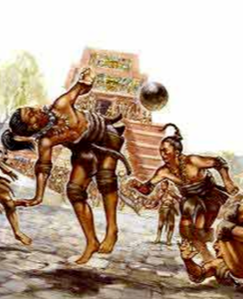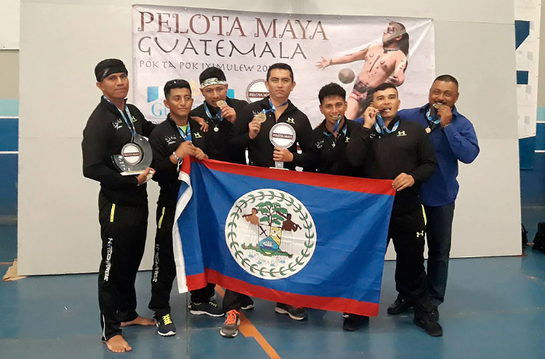Ancient Mesoamerican Ball Game
Written by Elizabeth A. Hays
Every week, a sports team celebrates a disappointing loss or a victorious win. In America, baseball and football dominate the summer and winter seasons. Rugby and soccer, also known as football, have taken over parks and fields in other parts of the globe. Sports competitions have not just recently become a favorite pastime. For centuries, they have dominated societies, and participation was mandatory depending on the group. Some of the more well-known games throughout history include Rome’s gladiators and Greece’s Olympians. However, the indigenous Latin American tribes participated in much more exciting matches.
Similar to most of South America’s history, there is not much written documentation of the tournaments played throughout the Andean region. It was not until the famous meeting between the Spanish explorer Hernán Cortés and the Latin American ruler Montezuma (Moctezuma) that the world began to learn about the western hemisphere's cultures. Among the various wonders described by Spanish journals during this time was an aggressive ball game played by the region’s tribes. Each group referred to the sport by a different name; for the Aztecs, it was known as Tlachtli, and the Mayans called it Ulamaztli or Pok-a-Tok. No matter its title, this competition was a dominating force throughout the different societies. Instead of using it solely as entertainment, groups used this Mesoamerican ball game for religious and social determinants, commonly ending in death.
Similar to most of South America’s history, there is not much written documentation of the tournaments played throughout the Andean region. It was not until the famous meeting between the Spanish explorer Hernán Cortés and the Latin American ruler Montezuma (Moctezuma) that the world began to learn about the western hemisphere's cultures. Among the various wonders described by Spanish journals during this time was an aggressive ball game played by the region’s tribes. Each group referred to the sport by a different name; for the Aztecs, it was known as Tlachtli, and the Mayans called it Ulamaztli or Pok-a-Tok. No matter its title, this competition was a dominating force throughout the different societies. Instead of using it solely as entertainment, groups used this Mesoamerican ball game for religious and social determinants, commonly ending in death.
|
American Indigenous Games: Mesoamerican Ball Game. N.d. 4.4 Million Days, Inc. Web. 20 Feb 2013.
|
This ancient fast-paced sport was a court game, typically played by men with a heavy rubber ball. The tools to play alone were a phenomenon for the Spanish explorers. Rubber was a foreign entity to Europe, and they were amazed by its resilience and elasticity. Archaeologists studying the Olmecs discovered they would combine the sap from the lowland rubber trees with the juice from morning glory flowers to create long-lasting rubber balls (Craig, 2002). A traditional court for this game consisted of stacked stones laid out tightly in an I-shape. The goal was to keep the ball in motion. Players passed the ball down the court by bouncing it off their bodies without using their feet or hands. Over time, game officials added a suspended stone ring along the sidelines, and if a player passed the ball through it, the team would be automatically victorious (Craig, 2002).
|
The Spanish did not only document this game to bring it to Europe. The foreigners were intriguingly appalled at its accompanying ceremonies. Like the Superbowl in the U.S., these games were a significant component of ancient Latin American culture. Not only did the participants provide entertainment for the masses, but the tournaments also played substantial roles in religious traditions, economic determinations, and socio-political judgments. Archaeologists can determine the game’s importance by outlining the number of playing fields with their locations throughout the ancient settlements. Some of the most well-preserved ballcourts rest in El Tajín and Chichén Itzá. Excavators found the courts in these notable regions close to the sites’ important temples and shrines. The uncovering of these spaces indicates that the tribes typically played in their site’s ceremonial centers (Earley, 2017). Historians also believe that religious feasts and performances were held on these playing fields because they could accommodate larger audiences.
Spanish documents narrating this period’s events corroborate these archaeological findings. For example, writings from a Dominican friar explain that men of all societal rankings probably played while leaders watched onward, and it was common for spectators to gamble on its outcome. This region’s indigenous tribes created different partnerships with one another, both good and bad. Survival was the ultimate goal for all, but leaders interpreted its meaning differently. Some believe that creating trade alliances was the key to a successful settlement, while others thought that territorial dominance was the answer. It was not uncommon for battling tribes to turn to the ballcourt to ensure organized war. Some scholars believe that territorial authority was not the only primary reason for playing the game, but that the ball’s movements mimicked different battles from the past. The players recreate past territorial wars, natural occurrences, or mythological fights. Commonly, the losing opponent resulted in human sacrifice, no matter the game’s ultimate purpose (Earley, 2017). The cultures expected the dying outcome because that was the respectable result of any war. Death was honorable to these tribes, for the executioners, the sufferers, and the rest of society. These games happened quite frequently, to the extent that some of the more prominent institutions dedicated entire cemeteries to the Place of Ball Game Sacrifice (Wilcox and Scarbrough, 1991). Leaders also believed they were honoring their gods through human sacrifice. The method in which they presented their gifts would cause distinct natural occurrences, such as sacrificing a warring opponent to end a drought.
Written narratives from European explorers, combined with archaeological excavations and antiquities, have provided the public with most of the information regarding these ancient Mesoamerican games. Over the centuries, the game traveled into the southern United States, the Caribbean, and Europe. It slightly evolved throughout its journey, but it maintained its indigenous roots.
Spanish documents narrating this period’s events corroborate these archaeological findings. For example, writings from a Dominican friar explain that men of all societal rankings probably played while leaders watched onward, and it was common for spectators to gamble on its outcome. This region’s indigenous tribes created different partnerships with one another, both good and bad. Survival was the ultimate goal for all, but leaders interpreted its meaning differently. Some believe that creating trade alliances was the key to a successful settlement, while others thought that territorial dominance was the answer. It was not uncommon for battling tribes to turn to the ballcourt to ensure organized war. Some scholars believe that territorial authority was not the only primary reason for playing the game, but that the ball’s movements mimicked different battles from the past. The players recreate past territorial wars, natural occurrences, or mythological fights. Commonly, the losing opponent resulted in human sacrifice, no matter the game’s ultimate purpose (Earley, 2017). The cultures expected the dying outcome because that was the respectable result of any war. Death was honorable to these tribes, for the executioners, the sufferers, and the rest of society. These games happened quite frequently, to the extent that some of the more prominent institutions dedicated entire cemeteries to the Place of Ball Game Sacrifice (Wilcox and Scarbrough, 1991). Leaders also believed they were honoring their gods through human sacrifice. The method in which they presented their gifts would cause distinct natural occurrences, such as sacrificing a warring opponent to end a drought.
Written narratives from European explorers, combined with archaeological excavations and antiquities, have provided the public with most of the information regarding these ancient Mesoamerican games. Over the centuries, the game traveled into the southern United States, the Caribbean, and Europe. It slightly evolved throughout its journey, but it maintained its indigenous roots.
|
Nunez, Dorian. Belize Celebrates Win At Regional Maya Ball Game Tournament. Belize, Oct. 2017.
|
Today, Latin American cities like Teotihuacan, Mexico, hold tournaments to honor and recreate this ritual, except it now does not end in human sacrifice. A 2017 Belize travel blog announced that their country won the current year’s tournament. The city, Teotihuacan, held this regional competition to remember and honor the ancient indigenous tribes. The different teams donned authentic clothing and regalia, hoping to teach future generations and other parts of the world about this Mesoamerican history.
|


